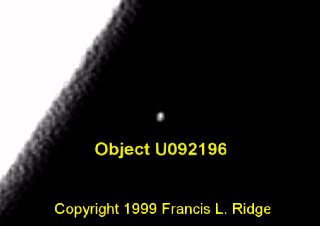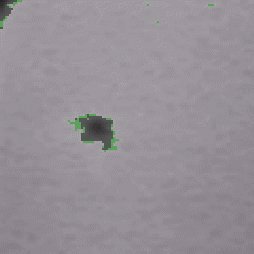

Solarized image from frame-grab
of object near the Moon.
Subject: U092196 to
avi file link
-
Date: September 21, 1996
-
Session #: 24
-
Lunar range: 228,722 miles, 95.75% of mean
-
Age: 9.5 days of 29.53 day cycle
-
Phase: 68.9% waxing
-
Orientation: Northern hemisphere up, normal
-
Sky conditions: Clear with a little haze, lunar halo.
-
7:26 PM local time, 00H26m CUT.
During routine scans of the lunar surface with the 16" scope equipped
with a CCD camera, The Lunascan Project team tracked an unknown object
near the SE lunar limb for twenty seconds. The Moon was under HPS Mode
(High-Power Scanning) at 400 power, putting the surface at less than 600
miles. The scope/camera system had been in manual control to the limb,
then used the Earth's rotation to slowly scan to the terminator. Once in
the darkness of the lunar night the system was manually pulled back to
the limb for another scan, each slice slightly different.
At the BOS (Beginning Of Session, 7:00 PM) the numbers for auto track
had been routinely punched into the DOB Driver II computer. However, since
the auto-track mode causes short L-shaped jerky movements during taping,
the computer is placed in Pan which is manual. As team members watched
the outside monitor, they noticed in the blackness of space to the right
of the Moon, a very brief bright speck. Due to deterioration of the weather
the session was terminated at 10:00 PM and the datatapes rewound.
At 00H26m CUT, queued on the tape, was the object. At first glance
it looked somewhat like a satellite of Jupiter. In fact, the object was
about that size. But no star, let alone any moon of Jupiter, had ever survived
the glare of the lunar limb. Not once during the last year and 23 other
sessions had the scope picked up anything that close. Immediately the facility's
main computer was booted up and EZ Cosmos was loaded. The status screen
read the current date and time. The exact time of the incident was punched
in and the sky chart was put onscreen. Upon zooming in on the Moon and
sky sector, to see if there was a bright star or planet nearby that could
account for the object, it was determined that nothing conspicuous was
anywhere near the Moon. Before the end of the hour a frame-grabbed image
had been placed on The Lunascan Project web site. By Monday afternoon a
complete report was filed.
-
Analysis shows shows target acquisition for less than a second, loss
of target for around six seconds, re-acquistion and recording for 13 seconds
before the scope/cam panned by Earth rotation let the object leave the
FOV at upper right. Almost 400 frames.
-
The FOV at HPS 400 was 306 miles wide by 241 miles.
-
Total time of observation was was 20 seconds.
-
The coordinates of the unknown were about: RA 19'.008 Dec -19 degrees
18' 00 Alt 32.00 Azm 172.00
-
Further checks with the brightness control turned up showed the lunar
surface features tracking with the object. Therefore the object's apparent
motion was zero.
-
The object's apparent distance from the lunar limb was 37 arc-seconds,
less than the apparent diameter of the planet Jupiter.
-
The object's size calculates out to be comparable to that of Ganymede
and measures about 2 mm on the monitor, or a little over 2.375 miles in
diameter at lunar range. With the help of numerous consultants the following
was determined: In general, the FOV is so restricted that SOME relative
motion should have been noticeable for just about everything.
-
Low Earth Orbit (LEO) satellite eliminated. Object's geocentric angular
speed is much too slow. The orbital period of LEO satellites are approximately
80 minutes, which is a geocentric angular velocity of 360 degrees every
1.5 hours or 0.075 degrees per second. In the 20 seconds the object was
observed, it should have moved about 1.5 degrees or three lunar diameters
(the angular diameter of the moon as observed from the Earth is 1/2 degree).
-
Geosynchronous satellite. A GSS would move .004 degrees per second relative
to the fixed stars (360 degrees in 24 hours). In 20 seconds, it would move
0.08 degrees, which is larger than the FOV. If the object were a geosynchronous
satellite, the movement should be easily noticeable because the object
would move out of the FOV entirely in 20 seconds.
-
Object cannot be a star or planet. No star or planet has ever been videotaped
during any of the previous 23 sessions due to the lunar glare. However,
the moon's monthly orbital period would cause the moon to move away from
a fixed star or planet at a rate of .00015 degrees per second, approximately,
IF it were possible to record such an event.
-
Balloon. Potentially motionless, a balloon drifting with the air currents
at a leisurely 10mph 100 miles away would still move .03 degrees in 20
seconds, or half the FOV. Since the telescope was elevated 32 degrees above
the horizontal, that would also put this hypothetical balloon at an altitude
of about 50 miles.
-
Meteor. The lunar escape velocity of 5400mph is the minimum velocity
at which a meteoroid can approach the moon. That is 1.5 times the maximum
lunar orbital velocity of 3400, and it is almost 10% of your FOV. The majority
of objects in the solar system would approach the moon at much greater
speeds.
Lan Fleming: Trajectories could be envisioned that could make such an
object appear stationary relative to the moon for 20 seconds to an Earth-based
observer, but the data now appears to be more in favor of an object in
lunar orbit. A maximum speed of about 3400mph for something in lunar orbit
translates into an angular velocity as viewed from Earth of .0002 degrees
per second. In the 20 second time span in which the object was in view,
that would produce an angular displacement relative to the moon of only
.004 degrees, or about 6% of the .06 degree FOV. But this is only for objects
orbiting near the surface of the moon. The speed decreases rapidly with
altitude, which would make the motion increasingly difficult to detect.
As for non-orbiting meteoroids, trajectories could again be envisioned
that would hide the true motion of the object in the lunar reference frame
from an Earth-based observer. But the set of possible paths that would
do this is going to be larger for a slow-moving orbiter than for a faster-moving
non-orbiter. This seems to favor the interpretation of the object as being
a lunar orbiter. It is also unlikely that astronomers would miss a 2-mile
long asteroid that got this close to Earth!
-
Asteroid. If this were an asteroid there should have been some movement.
JPL says something like 8-arcsec in 20-sec time-exposure is not unusual.
And we're not assuming an asteroid as a natural lunar orbiter. That would
be nearly impossible.
-
Object in lunar orbit. Mascons prevent anything from orbiting very long
without corrections. If it's in orbit, it is highly reflective, probably
much smaller than it appears, and man-made.
-
Internal reflection. Cam/scope bounce at beginning of track shows object
and Moon in-sync, similar to motion you'd get from observing Jupiter and
it's moons. This is not a reflection of any kind.
Lan Fleming: The lack of apparent motion relative to the moon could
be most easily explained by an orbiter. While the low-altitude orbital
speed at the moon is such that an object would move a maximum distance
of 5% of the telescope FOV in the 20-second observation time, there are
two points in a lunar orbit at which the object would appear to be motionless
relative to the moon as observed from Earth: the point in the orbit where
the object is moving directly toward the Earth and the point where it is
moving directly away. The two points would be close to the positions where
the object was farthest from the moon's limb and are the only places where
the object would likely be seen at all. Assuming the object was at the
apparent 45-mile altitude above the moon in the video image and had a two-hour
orbital period, there would only be a period of 11 minutes between when
the object emerged from behind the moon and when it moved across the moon's
disk where it would be lost in the direct moon light. Within that 11-minute
time span, the object might be visible for only a few seconds at its farthest
distance from the moon's limb before it became lost in the bright moonlight
diffused though the Earth's atmosphere close to the limb. (The image that
Francis has on his web site shows this atmospheric haze around the moon.)
Such an object might therefore appear suddenly and disappear just as suddenly
after the 20-second period that Mr. Ridge observed the object. That would
make an object orbiting the moon a more likely explanation than an asteroid
travelling straight toward Earth. The only problem with the orbiter hypothesis
is that the chances of the moon capturing an asteroid seem to be close
to nil. It's low gravitation would make captures rare, and the orbit would
quickly degrade due to the the gravitional anomalies associated with mascons.
The estimate I've heard is that any orbiting object will either escape
the moon or impact it within about a year.
Lan Fleming: I wrote: there are two points in a lunar orbit at which
the object would appear to be motionless relative to the moon as observed
from Earth: the point in the orbit where the object is moving directly
toward the Earth and the point where it is moving directly away. The two
points would be close to the positions where the object was farthest from
the moon's limb and are the only places where the object would likely be
seen at all. I should have qualified that a bit. This would only apply
for an object in a lunar orbit if the orbital plane were perpendicular
to the the plane of the telescope field of view. If the orbital plane were
instead parallel to the FOV plane, the object would appear to be circling
the moon at more-or-less constant altitude and speed. The orbital plane
would probably be somewhere between the two extremes. However, most asteroids
travel in the ecliptic plane, so if one happened to get captured by the
moon, its orbital plane would be in the ecliptic. Since the ecliptic is
very nearly perpendicular to the plane of a telescope FOV, the orbiting
object would appear nearly motionless from Earth at its maximum distance
from the moon's limb. A second possibility might be some tank on some probe
venting for some reason. The resulting gas cloud could be visible from
Earth before it disappeared after a matter of seconds. And, in fact, the
report reminds me the cloud people saw when Apollo 13's tank gave way --
a spot of light that was gone again in seconds. (That one was easily visible
to the naked eye, I think I remember ... but it was 100,000 miles away,
not 250,000 miles.)
One-hour video documentary with report and footage on U092196 available.
Shipped Priority Mail. Send money order for $23 to:
The Lunascan Project
618 Davis Drive
Mt. Vernon, IN 47620


